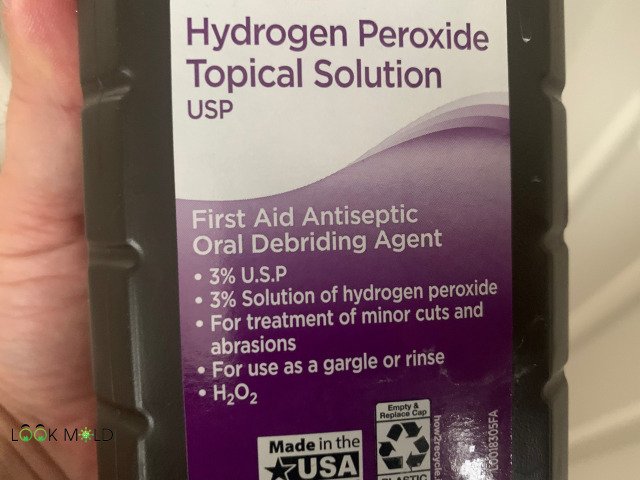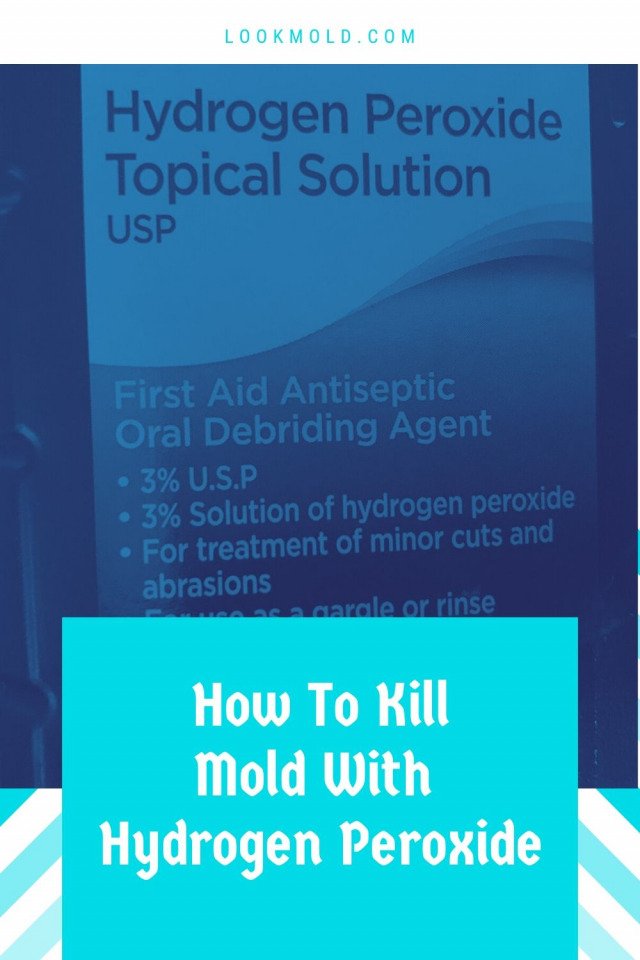Many different people have many different theories on what should be used to kill mold.
Some people will recommend bleach. Not only can this be unsafe to use in your home to kill mold, but there have also been studies that suggest it's not useful in penetrating porous surfaces.
Other people may suggest vinegar, which can be great but may not kill all species of mold.
And then you have mold remediation professionals who use some toxic chemicals that work well.
But how about a disinfectant that you may already have in your home?
Does hydrogen peroxide kill mold?
In this article, we will explore if hydrogen peroxide (h2h2) can be used to get rid of mold within the home and what you should know before using it.
Does Hydrogen Peroxide Kill Mold?
 The common belief is that 3% Hydrogen Peroxide can be used to kill mold. While this is true to a certain extent, 7% and 13.4 % (which is not yet approved by the FDA) Hydrogen Peroxide has been scientifically proven to kill mold more effectively in a quicker amount of time.
The common belief is that 3% Hydrogen Peroxide can be used to kill mold. While this is true to a certain extent, 7% and 13.4 % (which is not yet approved by the FDA) Hydrogen Peroxide has been scientifically proven to kill mold more effectively in a quicker amount of time.
In 2008 the CDC released guidelines that indicated that 3% Hydrogen Peroxide is useful as a disinfectant but not quite as clear results as an antimicrobial solution.
A separate study done by a German company in 2010 indicated a significant reduction of mold spores in a highly contaminated building environment using 5-6% Hydrogen Peroxide.
There have been no studies done on the effectiveness of H2H2 on every single genus of mold. However, there haven't been studies on every indoor mold spore type with any antimicrobial solution on the market, so you would expect that it works well on many different spore types.
Bottom line is:
3% Hydrogen Peroxide should be used to remove mold or mildew on the surface on non-porous surfaces. Still, it should be at a higher percentage when used in a mold-contaminated environment.
Caution on High Percentage Hydrogen Peroxide
Just like anything else, too much of one thing is never good. Caution should be taken if using high concentrations of Hydrogen Peroxide.
It has been reported that high concentrations of Hydrogen Peroxide on the skin can cause irreparable skin damage.
If you are not educated on the effects of higher than 3% Hydrogen Peroxide, you should only not be using it.
All labels should be thoroughly read before using it.
Does Hydrogen Peroxide Kill Black Mold?
During clinical studies, there was no evidence that Hydrogen Peroxide kills black mold (scientific term Stachybotrys). While Hydrogen Peroxide has been known to kill mold it should not even be attempted to kill black mold because black mold can affect humans regardless if it’s dead or alive. If water damage extensive enough is present in a home that it has black mold, mold remediaton will need to take place.
By just killing black mold with any solution including Hydrogen Peroxide, the indoor living areas can be compromised by the mold colonies being disturbed and then aerosolized.
How To Get Rid Of Mold With Hydrogen Peroxide
 If you decide you want to use Hydrogen Peroxide to remove mold on non-porous surfaces such as plastic or metal, it is quite simple to do. You can simply do the following steps:
If you decide you want to use Hydrogen Peroxide to remove mold on non-porous surfaces such as plastic or metal, it is quite simple to do. You can simply do the following steps:
- Step 1: Fill a spray bottle up with Hydrogen Peroxide
- Step 2: Spray surface with mold build up in a complete manner so moldy areas get saturated through hydrogen peroxide.
- Step 3: Allow the Hydrogen Peroxide to sit on the surface for 2-5 minutes
- Step 4: Wipe the surface down with a cloth or other fabric
Benefits of Hydrogen Peroxide for Mold Removal
Hydrogen Peroxide has been used for years in many different medical capacities and is in many household solutions.
However, there are many advantages to using Hydrogen Peroxide instead of other solutions for mold clean-up such as:
- The aggressive antimicrobial efficacy that you get through Hydrogen Peroxide helps in cleaning space without posing any risks to the health.
- Cleaning the mold through hydrogen peroxide begins with oxygen release and breakdown of molds. The ability to oxidize also helps the cleaning agent in combating stains and malodor.
- One more advantage of using hydrogen peroxide is that doesn't generate any byproducts that are hazardous to the environment. As this is constructed through oxygen and hydrogen, the cleaning agent doesn't decompose any harmful decomposition agents but oxygen and water.
Conclusion
Yes, Hydrogen Peroxide is proven to kill some types of mold, and it is one of the solutions that will cause the least amount of ill effects on humans.
While there are other options available, Peroxide is safe to use, inexpensive, and can be used as a disinfectant to kill other bacteria and viruses.

Meet the author: Brad Fishbein is an ACAC council-certified Microbial Investigator. In the fall of 2012, he became a Licensed Mold Assessor in the State of Florida through the Department of Business & Professional Regulation. Brad has helped homeowners with over 5,000 successfully completed Mold Inspections since 2009.

